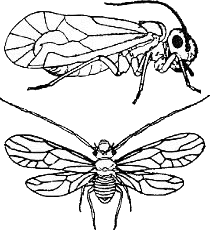Psocodea
Pronunciation: [So⋅CODE⋅ee⋅ah]
Pronunciation: [So⋅CODE⋅ee⋅ah]
Common Name: Barklice / Booklice / Parasitic lice / Biting lice / Sucking lice
In the past, members of this order have been classified under different order names including Corrodentia (barklice), Psocoptera (barklice and booklice), Phthiraptera (parasitic lice), Mallophaga (chewing lice), and Anoplura (sucking lice).
Greek Origins of Name: Psocodea is derived from the Greek “psokos” meaning rubbed or gnawed. Loosely translated, the name could be taken to mean “insects that gnaw”, but that is not really accurate because some of the parasitic lice have sucking mouthparts.
Barklice: Neck-like constriction between head and thorax. Adults with wings held tent-like over body. Thread-like antennae.
Booklice: Neck-like constriction between head and thorax. Small and wingless. Thread-like antennae.
Parasitic lice: Small and wingless. Sucking lice have a conical head that is narrower than the thorax. Enlarged tarsal claws of sucking lice are adapted for gripping individual hairs of the host. Chewing lice have a broad, flat head that is as wide as, or wider than the thorax.
Hemimetabola, i.e. incomplete metamorphosis (egg, nymph, adult)
Paraneoptera; closely related to Hemiptera.
The order is divided into three suborders: Trogiomorpha (some barklice), Troctomorpha (parasitic lice and booklice), and Psocomorpha (other barklice).
Abundant worldwide. Booklice and barklice are often overlooked because of their secretive habits. Parasitic lice are common ectoparasites of birds and mammals. Approximately 40 families and 1250 species in North America and 60 families and ~11,000 species worldwide.
Barklice generally live in moist terrestrial environments (in leaf litter, beneath stones, on vegetation, or under the bark of trees) where they forage on algae, lichens, fungi, and various plant products. They may grow to 10 mm in length and are frequently winged during the adult stage. Some species are gregarious. They often live in small colonies beneath a gossamer blanket spun with silk from their labial glands.
Booklice are more common in human dwellings and warehouses. They are wingless and much smaller than barklice (less than 2 mm). Most species feed on stored grains, book bindings, wallpaper paste, fabric sizing, and other starchy products.
Parasitic lice are wingless external parasites of birds and mammals. Biting lice were probably the first to evolve. Like barklice, they have chewing mouthparts but feed primarily on the feathers and dead skin cells of birds. A few of these lice apparently developed the habit of breaking their host’s skin and feeding on its blood. This lineage presumably gave rise to to the sucking lice which have piercing-sucking mouthparts and feed as ectoparasites on the blood of placental mammals.
Parasitic lice cannot survive long if separated from the body of their host. Eggs (called nits) are glued directly to the hair or feathers and nymphs feed on the parental host. Since parasitic lice have no wings, dispersal to new host animals is limited to occasions when members of the host species come into direct contact with each other. This close interspecific association means most parasitic lice are limited to a very narrow host range — often only a single species.


Most barklice are woodland insects. These insects are rather secretive and seldom come into contact with humans. Booklice can tolerate drier environments and may sometimes inhabit homes and warehouses. They occasionally become a nuisance, but they seldom cause economic damage.
Parasitic lice are responsible for the spread of disease in humans and domestic animals. Pediculosis is an infestation of lice anywhere on the human body. It is usually characterized by skin irritation, allergic reactions, and a general feeling of malaise. In addition, the human body louse is responsible for the spread of relapsing fever (Borellia recurrentis), epidemic typhus (Rickettsia prowazeki), and trench fever (Rickettsia quintana). Lice assocated with domestic animals have also been implicated in the transmission of disease (e.g., hog lice spread pox virus and cattle lice spread rickettsial anaplasmosis). Biting lice do not usually spread disease pathogens, but heavy infestations can cause severe skin irritation, weight loss, and reduced egg production.
Barklice:
Booklice:
Parasitic lice: